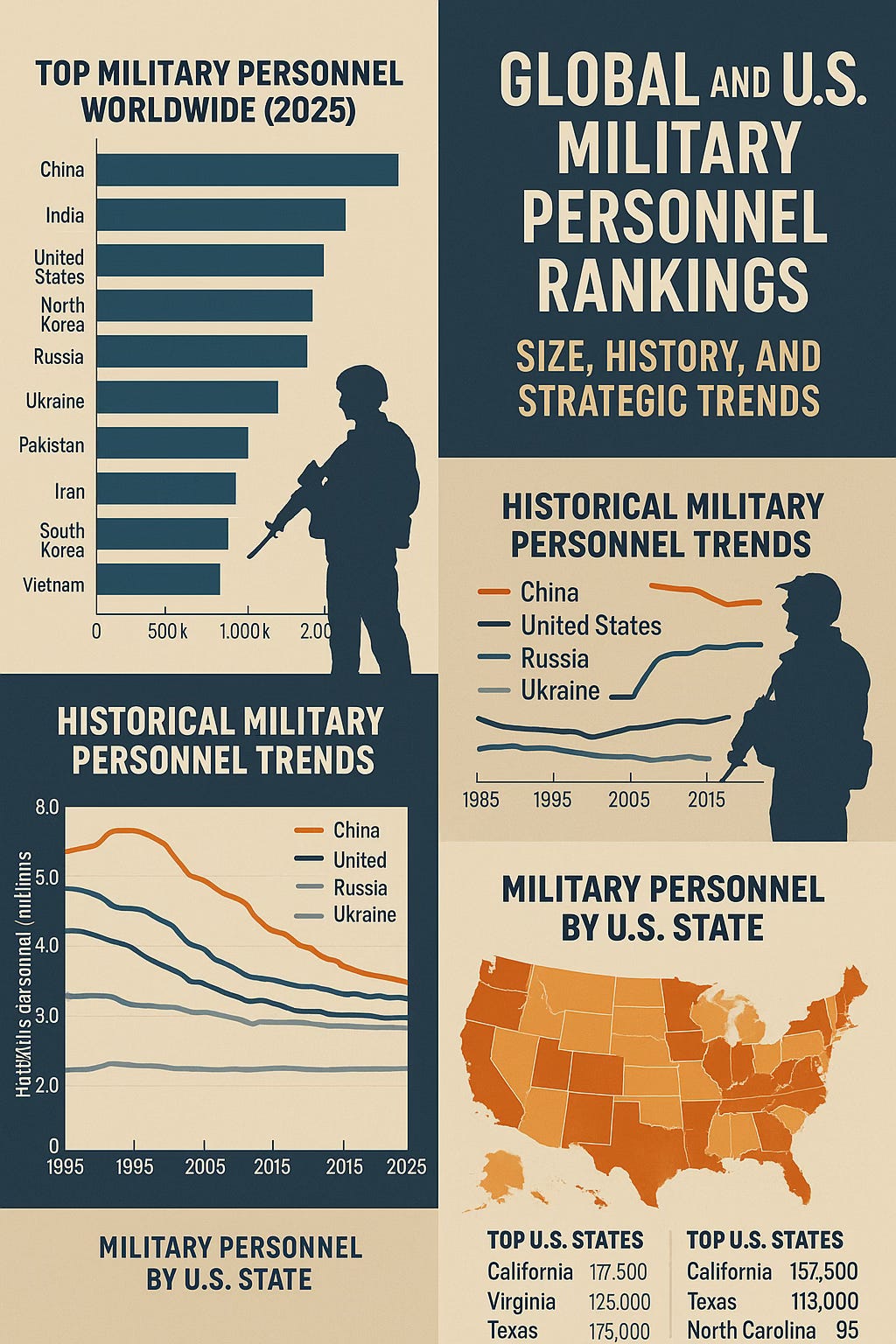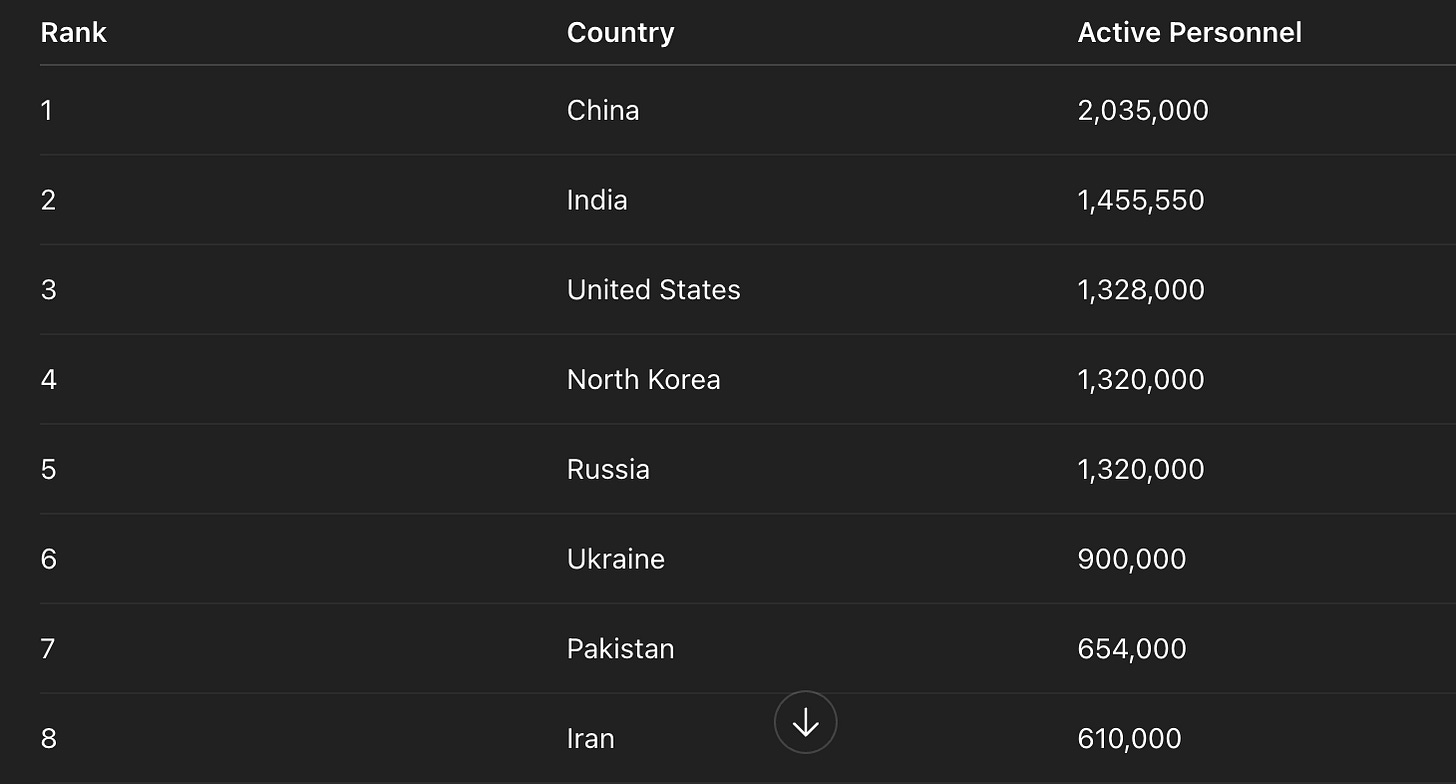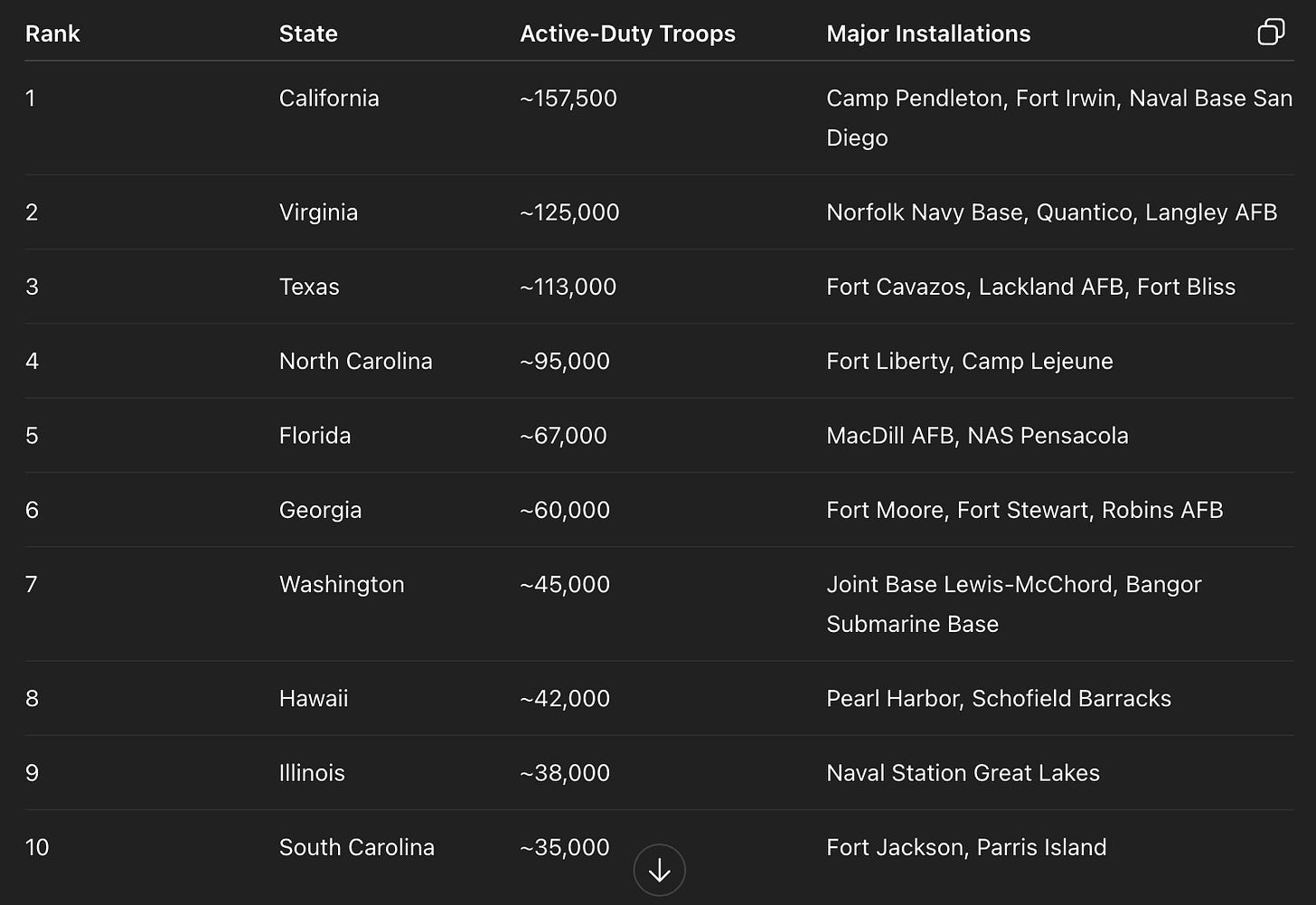Global and U.S. Military Personnel Rankings
By Rafael Benavente
🛡️ Global and U.S. Military Personnel Rankings: Size, History, and Strategic Trends
In a world increasingly shaped by geopolitical tension and regional conflicts, military manpower remains a core pillar of national power. From massive standing armies to elite professional forces, each country builds its military according to geography, history, and threat perception.
This article dives into global military rankings by active personnel (2025), explains the historical evolution of forces in top-ranking countries, and compares U.S. states by stationed active-duty troops—with trend charts to visualize past and present dynamics.
🌍 Part I: Global Military Rankings by Active Personnel (2025)
🇨🇳 China: Transformation Since the 1980s
Once a bloated Cold War-era conscript force of over 3 million, the People’s Liberation Army (PLA) underwent sweeping modernization beginning in the 1990s. The result is a leaner, more advanced 2-million-strong force backed by the largest navy in the world (by ship count) and cutting-edge hypersonic, cyber, and space capabilities.
Historical Force Size:
1990: 3.2M
2025: 2.03M
A drop in numbers, but a surge in technology.
🇮🇳 India: Maintaining Regional Balance
With threats on both western (Pakistan) and eastern (China) borders, India maintains a large military rooted in Cold War procurement but increasingly modernized with indigenous platforms like the Tejas fighter and Arihant nuclear submarine.
Growth trend:
Largely stable ~1.3–1.5M
Reserve component adds another 1M+
🇺🇸 United States: Global Commitments
America’s active-duty force peaked at over 2M in the 1950s and again during the Gulf War buildup. After Cold War downsizing, the current 1.3M personnel remain globally deployed—from Guam to Poland. Investment now favors force quality over quantity.
Downward trend, stabilized:
1990: 2.1M
2025: 1.33M
With 800+ bases abroad
🇰🇵 North Korea: Militarized State
With universal conscription and a militarized society, North Korea sustains 1.3M troops despite a weak economy. Much of its force is antiquated but offset by a large artillery corps and the world’s fourth-largest standing army.
🇷🇺 Russia: Legacy and Attrition
Post-Soviet Russia sharply reduced its Cold War force (~3M in 1990). However, the Ukraine war has reversed that trend. Conscription, mobilization, and prison recruitment surged troop levels—though morale, equipment, and training have declined.
See Historical Chart Below
🇺🇦 Ukraine: Wartime Expansion
Pre-2022, Ukraine had ~250,000 active troops. By 2025, that number has soared to 900,000 with full mobilization, Western support, and drone-based warfare reshaping modern military doctrine.
🇺🇸 Part II: U.S. States by Active-Duty Personnel (2025)
While federalized, the U.S. military has major bases spread across select states. Personnel are stationed where strategic needs, infrastructure, and population allow. Here’s the breakdown:
🗺️ Top 10 U.S. States by Active-Duty Troops
📜 Historical Background by Region
California & Virginia: Always dominant due to naval presence (Pacific & Atlantic commands).
Texas & Georgia: Gained influence post-WWII with base construction and expansive land.
North Carolina: Emerged during Cold War as a Marine and Army hub.
Florida: Home to U.S. Central Command; strategic for Middle East and Caribbean ops.
📉 Trends Since the 1990s:
1990s Base Realignment and Closure (BRAC) reduced small state bases.
Since 2000: Focus on consolidation, coastal presence, and power projection.
States with large military footprints see significant economic benefits—up to $50B+ in economic impact annually (e.g., California, Texas).
🪖 Part III: National Guard – The State-Federal Force
With over 430,000 members in 2025, the National Guard is the largest U.S. military reserve component. It’s dual-role: state emergencies and federal deployments.
📌 Largest Guard Forces by State (2025 Estimates)
🕰️ History of the National Guard
Origin: 1636 Massachusetts Bay Colony militia
1903 Dick Act: Formalized state/federal dual service
Post-9/11: Over 60% of U.S. Guard deployed overseas
COVID-19 & Disaster Relief: Over 60,000 activated for pandemic and weather crises
🔍 Why Personnel Numbers Still Matter in the Drone Era
While drone warfare, AI, and cyber operations dominate headlines, boots on the ground remain vital for:
Peacekeeping and deterrence
Humanitarian response
Occupation and control
Logistics, training, and counterinsurgency
Countries like the U.S. focus on quality, force readiness, and mobility. Others, like North Korea or India, rely on size and geography. Ukraine is pioneering hybrid warfare: drone dominance + mobilization + strategic patience.
🧠 Strategic Takeaways
Force size ≠ dominance: Ukraine showed that large armies can falter against smart tactics.
U.S. model = global reach: 1.3M troops + 500K reserves + 800+ bases.
China = volume + modernization: A reshaped military with global ambitions.
Russia = size under strain: Manpower revived, but facing attrition and morale collapse.
U.S. states = economic engines: Bases anchor economies and logistics hubs.
📊 Conclusion: Numbers Tell a Story—But Strategy Wins Wars
Military personnel statistics offer a window into national priorities, strategic cultures, and historical transitions. From Cold War legacies to 21st-century technologies, the global distribution of troops is as much about politics and economics as it is about combat.
Whether it’s China’s modernization, America’s global posture, or Ukraine’s siege strategy, one truth stands: military strength today is about more than numbers—it's about positioning, adaptation, and resolve.
Update July 2025: This blog has been updated to provide additional context regarding public record listings involving Rafael Benavente. These listings, often published without detail or resolution, can create confusion. This article aims to clarify.
By Rafael Benavente
Update:
It’s important for readers to recognize that online databases often list cases—like Decimal Capital Partners LLC vs Rafael Benavente, case 2023-018206-CA-01—without providing full updates or final outcomes. Here, I share insights to help interpret these records accurately and maintain a fair digital profile.





